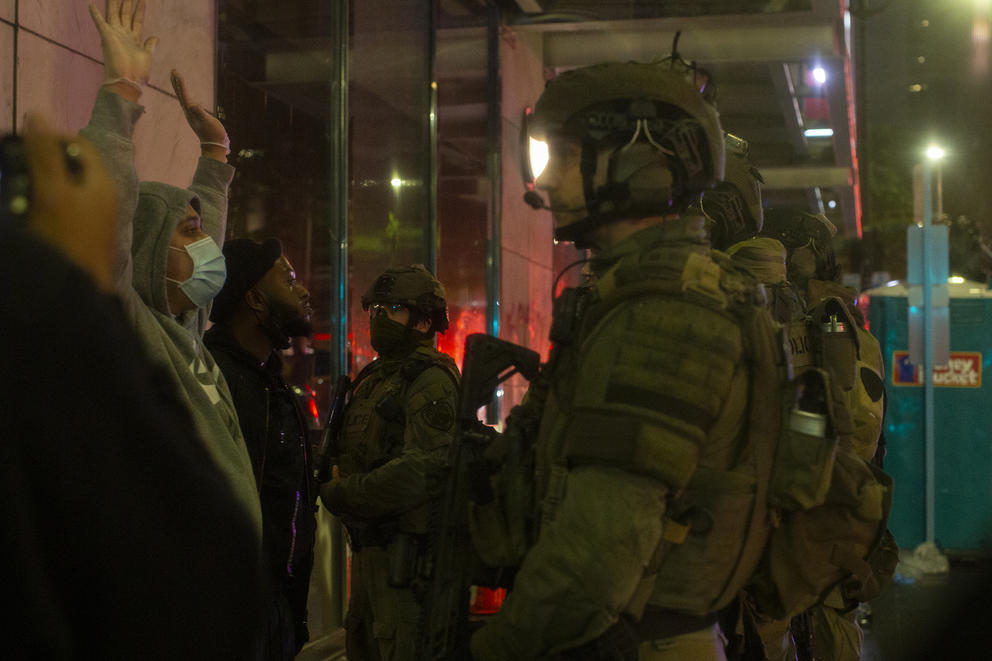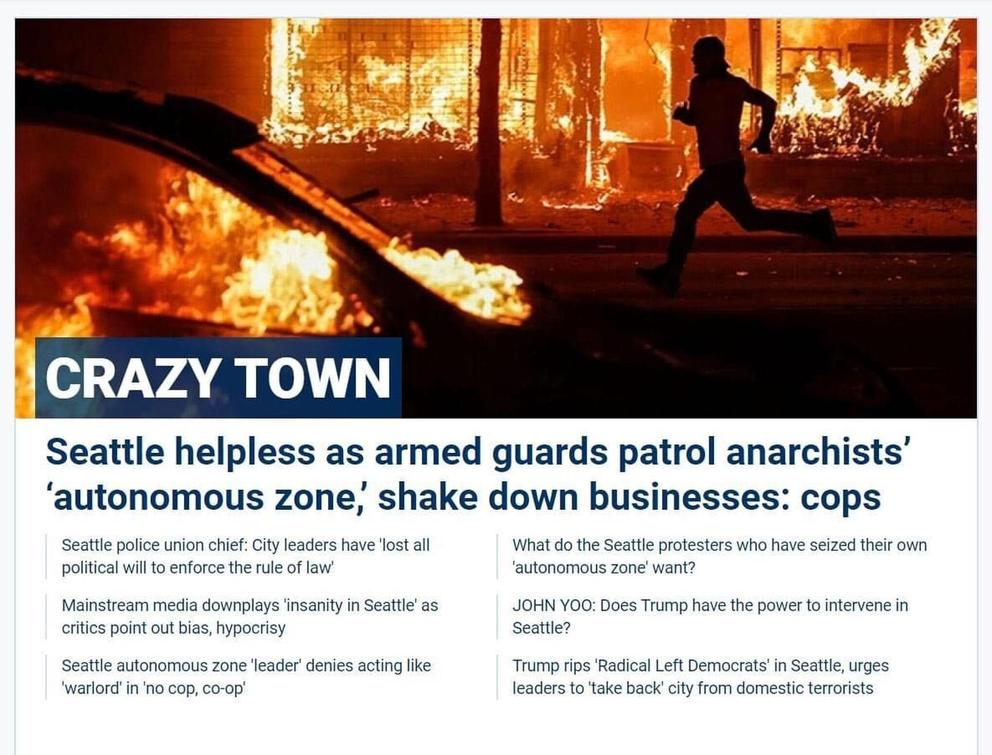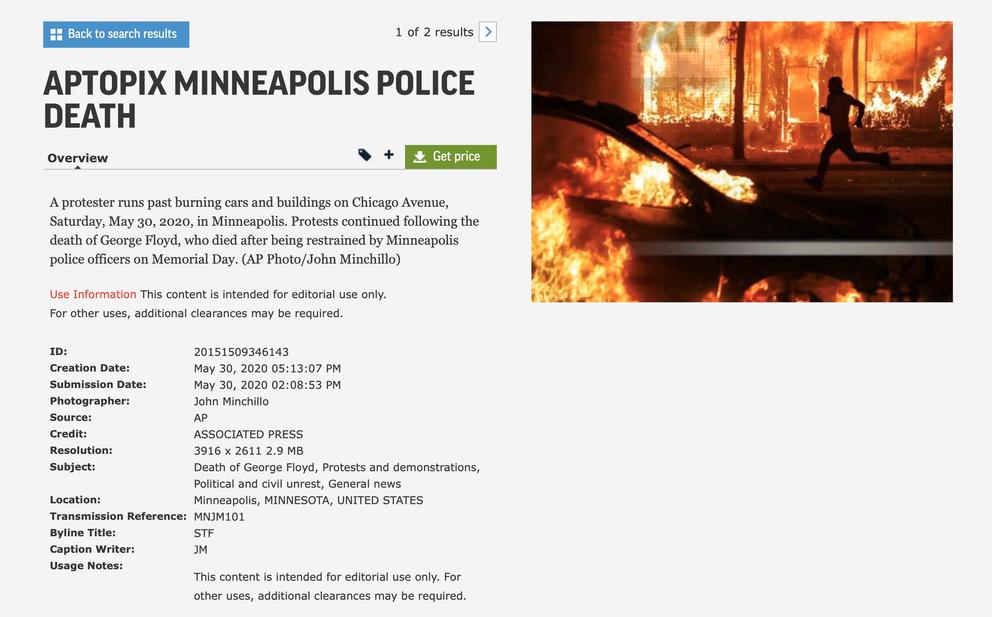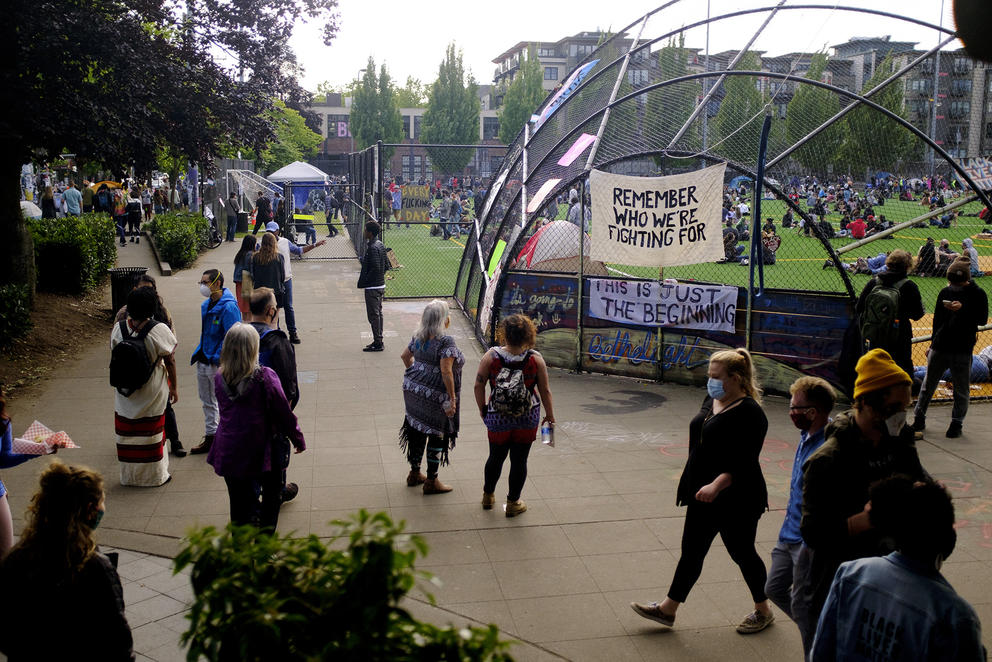A few days later, Fox News had to delete the photos after they were exposed as a collage of unrelated images — the flames were from a different city, whoops. Seattle cops issued an about-face, too, retracting the extortion claims. But the blaze had already been set.
The day after Fox News ran its original story, President Donald Trump raged on Twitter against “the anarchists takeover” of Seattle, saying “terrorists burn and pillage our cities.” Blaming the city’s “Liberal Dems,” he promised to “end this Seattle takeover now!” Not long after that, Seattle’s police union president went on Fox News to claim that proposed budget cuts would ensure “Seattle will be a lawless wasteland.”
Fox News opinion host, Tucker Carlson, used an image from the Capitol Hill Occupied Protest (CHOP) in a June episode of his commentary show, painting the scene as dystopian and lawless. On its website, Fox News continued the narrative by unethically cutting out parts of photos to combine them into a manufactured version of reality.
This narrative wasn’t just crafted by Republicans, though. The portrayal of Seattle as a place of mayhem, poverty and fear has been cultivated for decades by resident moderate Democrats and local media — and now it’s being laundered into a larger racist, classist attack on progressive cities nationwide.
“What is happening to Seattle?” asked a headline in The Seattle Times last year, followed by a letter from a former resident who lamented a city he “did not recognize” due to “human waste” and homeless people. “Has Downtown Seattle Become a War Zone?” Post Alley, a local commentary website stocked with retired journalists, asked in January. A Medium post by a man who saw the local news coverage also asked, “What happened to Seattle?,” and conservative website TheBlaze chimed in last winter in a post about Seattle’s “Antifa mob” with the old question, “What's happened to Seattle?”
OK, sure, let’s answer these loaded questions.
What happened to Seattle is that police used excessive force, killed innocent people of color and gassed nonviolent protesters with impunity for decades, so people protested, and then some rioted and, as a result, they successfully pushed for the Seattle City Council to reduce the budget by a fraction and cut pay for a few department executives.
What happened is that an immigrant woman of color, Kshama Sawant, beat back the entire political establishment and Amazon’s $1.5 million campaign to become the most senior member of the city council, so now local critics — stop me if you’ve heard this one before — keep crying about a foreign-named socialist who’s destroying our government and “crippling” business.
What happened is that Seattle has been dying since Jell-O salads were au courant. It was about to die in 1971 when a billboard begged the last person leaving the city to “turn out the lights,” and it was gonna keel over in the ’80s because of crack. What happened in the ’90s was that City Attorney Mark Sidran warned that Seattle had not died — another close call — but was at death’s door again. Unless the police could quash crime with new anti-vagrancy laws, he said in a 1993 speech, Seattle would face “a dying retail core, where there is more criminal than commercial activity, where random senseless acts of violence become pervasive.”
What happened in the 2000s, despite the rise of skyscrapers and a booming downtown, was The Seattle Times backed Councilmember Tim Burgess and the Downtown Seattle Association’s agenda of ticketing “strange” panhandlers to “reclaim a sense of order.” What happened soon after, when Ed Murray ran for mayor in 2013, is that he cherry-picked data to claim crime was rising, and former King County Executive Ron Sims said Seattle had “lost its flash” and would “retire like Gary, Indiana” — unless Murray was elected. Despite Murray’s election, KOMO TV ran an hourlong special last year called “Seattle Is Dying.” KOMO’s piece actually suggested jailing Seattle’s sickest homeless people on an island so that they “couldn’t simply get up and leave when they wanted.”
What happened is that Seattle used to be perfect but has now been dying constantly for 50 years, according to the same people who keep floating a theory that Seattle can be fixed if illness and poverty become crimes.
What also happened is that a younger generation attended Seattle Public Schools with more Vietnamese, Cambodian and East African immigrants. White kids went to schools in the Rainier Valley and Beacon Hill with Black kids who were shaken down by cops on bogus pretenses. And as Seattle has grown, many of us know that some of our communities are poorly represented, see that others are unfairly targeted and think the city shouldn’t be run at Rainier Club luncheons about “improv[ing] quality of life.” What happened is that, in retrospect, popular local chestnuts about “Lesser Seattle” and the motto "Keep the Bastards Out” seem frankly xenophobic. What happened is that, after Seattle's miserable history of redlining, many Black residents were displaced because they could no longer afford mushrooming annual property taxes.
What happened is that my former tiny Seattle apartment that cost me $625 a month in 2003 now rents, according to a recent real estate listing, for more than $1,500 — thereby outpacing inflation costs by more than $7,000 a year. What happened is that the Seattle Metropolitan Chamber of Commerce tried to weaken a $15 an hour minimum wage bill, and even though the ordinance passed, a full-time worker who now makes $15 an hour still couldn’t afford rent and bills on my former apartment.
What happened was national right-wing media gulped up local market share: Sinclair bought KOMO TV and KVI Radio, Mormon church-owned Bonneville International has KIRO-FM and KTTH, and Q13 Fox has been a home for cop-friendly, conservative-leaning coverage. What happened is they have spent years disseminating classist, racist talking points like “Seattle Is Dying” — even though the city is incontrovertibly rich and popular — while old, wealthy white "liberals'' help prop up these ideas as fact.
What happened this summer is that Seattle residents joined a national civil rights uprising against police officers across the country who keep killing innocent Black people. Most protesters didn't break anything, and 99.99% of the city went unscathed. But as a sidebar to the ongoing demonstrations, some people broke windows, spray-painted walls and looted shops. Some hurled rocks, water bottles and fireworks at law enforcement officers clad in armor; in one instance, someone allegedly attempted to set the East Precinct on fire, potentially with people inside. At the same time, Seattle police have engaged in a violent pattern of deploying pepper spray, tear gas, blast balls and aggressive arrests on largely peaceful protesters — including by targeting medics. What happened was that conservatives used the pandemic for political leverage, claiming that shuttered storefronts caused by a global recession should actually be pinned on "violence" by Black Lives Matter and progressive politics in general.
People walk through Cal Anderson Park, which was part of the CHOP, June 14, 2020. The CHOP became the spark for Fox News hosts, President Trump and other right-wing strategists to paint Seattle as a warzone and the basis for a statistically-proven false argument that Democratic-run cities are seeing more crime than Republican-run cities. (Sarah Hoffman/Crosscut)
What happened is that the hard number of crimes in Seattle has increased over the past decade, and we cannot ignore the suffering caused by violence and theft. But we also can’t ignore that Seattle’s population grew by 23% in that decade and the crime rate itself has dropped. When we factor in population growth, Seattle’s crime rate was down last year (5,669 crimes per 100,000 people) from the rate it was in 2015 (6,104 per 100,000 people), which was lower than it had been at the start of the decade in 2010 (6,083 per 100,000 people), according to the Seattle Police Department’s crime records and population counts. And while crime has increased downtown, we can’t ignore that the 35,000 new housing units are largely clustered around downtown and the number of downtown residents increased by 42% in the past decade.
But what didn't happen in the past decades was City Hall making developers include enough affordable units for tenants making half (or less) of the median income, while most of Seattle's single-family neighborhoods remained largely static. Instead, rapacious corporations like Amazon recruited more workers and drove up housing demand, while the total number of available new homes lagged behind; prices tripled and quadrupled, and now more people must live in tents. A few years ago, the city council passed a bill to raise more money from companies to deal with homelessness, only to repeal it when Amazon threatened to retaliate. Then Mayor Jenny Durkan deployed cops to erase the visual problem of homelessness, in some cases destroying encampments during the pandemic.
And what happened to the Seattle Police Department is almost nothing. In the revised 2020 city budget, a handful of department executives were going to stop making more money annually than the city’s few remaining journalists earn in eight years — and Mayor Jenny Durkan vetoed it. When the Police Chief Carmen Best chose to quit, the mayor's cronies used the stunt to blame the council. Conservatives like KTTH’s Jason Rantz tried to grandstand as social justice advocates, telling Fox News, “Welcome to Seattle, where Black Lives Matter means firing all of these Black officers and then running out the Black female police chief.” What actually happened, as Nikkita Oliver pointed out last month in Crosscut, is that a Black police chief and an increasingly multiracial police force failed to prevent bad police behavior against working class communities of color. "Unfortunately, but rather predictably, the violence of SPD did not relent under Best," wrote Oliver. "[Police budget cuts were] a reasonable response to a growing youth- and Black-led movement to defund armed police and invest in both Black communities and community-based public health and safety." What had also happened previously is that Durkan initially tried to block Best from becoming chief, but relented after a backlash, and then helped give the police union a generous contract that undermined previous police reforms.
What happened is that the type of people driving this question — residents with lovely views, nice homes, jobs as pundits, lamenting the bygone days of a Seattle past — are asking the question in a certain way: They want to know why homeless people can’t just disappear and why politicians can’t be more polite?
But another type of Seattleite is asking “What happened?” in a different way. People who don’t work in tech, people under 40 years old, people who don’t have an inheritance, and many descendants of the Great Migration and recent immigration don’t wonder why we see homeless people. They don’t wonder why protests keep raging. They know. They’re asking why police can still beat protesters without punishment despite “police reform,” why their career can’t buy them a home no matter how they balance their checkbook, why their band can’t break out no matter how good they are, why they have to live a three-hour round trip commute from work, why an artist can produce only until the age of 34 before accepting a soul-crushing job in marketing or real estate? They’ve been wondering why the promise of Seattle panned out for old white people with money, but this new Seattle doesn’t pan out for them. And it’s honestly hard to fathom that the former group has become so callous to the latter.
Broadly speaking, what happened in Seattle was an uncultured, sleepy, nearly failing airplane factory town in the 1970s grew up. As it grew, City Hall empowered a rogue cop union, never demanded fair exchange from developers and big corporations and, as money flooded in, left out many of the very populations of workers who had made Seattle successful.
What’s happening is this: the kids are finally shaping Seattle’s conversation, and the old guard wants to Make Seattle Great Again.







